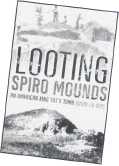|
Grave robbers and academics

Looting Spiro Mounds: An American King Tut's Tomb
By David LaVere 2007, University of Oklahoma Press, Norman, Oklahoma 206 pages, plus notes and index Paperback, $24.95
|
The subtitle of David LaVere's Looting Spiro Mounds is a footnote to perhaps the greatest public grave robbery in history: Howard Carter's 1924 discovery, opening, and emptying of King Tutankhamun's tomb in Egypt's Valley of the Kings. That story, which ran in the London Times and captured headlines around the world, legitimized treasure hunting in ancient cemeteries and fueled the market in burial antiquities, especially for Native-American artifacts in the United States.
Here in the Midwest, grave goods from Cahokia Mounds and other prehistoric sites around the country made their way into some of the largest private collections in the world. When Edward W. Payne, a Springfield banker, real estate investor, and board member of the Illinois State Historical Society, died in 1932, he had amassed what many consider the largest collection of Native-American artifacts in the world. Valued at more than $3 million at the height of the Depression. Payne's collection was auctioned off in 1937 to pay his several debts. Some of his collection went to Dickson Mounds in Lewistown, but much of it went back into private hands.
Payne, another footnote in LaVere's book, died one year before Spiro Mounds, Mississippian mortuary site in northeastern Oklahoma, was "mined" for its riches. But in this case, the treasure hunters made no pretense of collecting and protecting Native-American history for posterity. What they found was an incredible cache of Native-American artifacts, including stunningly engraved sea shells, beautiful copper plates and jewelry, pristine points and spearheads, thousands of pearl beads, and rare effigy pipes. Their goal was simple: To find and sell ancient Indian relics for profit, and their Pocola Mining Company operated fully within the law. The owners had legally leased the property on which the dozen mounds sat, and the miners went about their work vigorously with pick and shovel.
There were no state or national laws at the time to prevent the ''pot hunters," as they are still euphemistically called, from digging into the mounds, and only University of Oklahoma professor Forrest E. Clements, chair of the Anthropology Department, stood in their way. Clements had other plans for the artifacts. He wanted them collected, stored and studied by anthropologists, such as himself. Clements knew that the Spiro collection could put his university on the map, and perhaps even make him famous. He favored excavation by professionals, not by pot hunters.
Such is the plot of LaVere's fascinating book, which presents the drama of these unlikely players as they struggle for control of the richest cache of Native-American artifacts in modern history. To the author's credit, neither Clements nor the pot hunters come off as villains, but neither are they heroes. Certainly there are no winners, as whatever historical context that might have been uncovered at Spiro Mounds was forever destroyed.
Contemporary archaeologists consider the looting of Spiro Mounds one of the great cultural crimes of the century, though few outside the profession today even know of the site's existence.
Comparisons to King Tut and the Valley of the Kings are apt. The site rivals Cahokia Mounds in Collinsville, the largest Native-American earthwork in North America, in complexity and significance, and it is that story, the piecing together of the all-but-obliterated history of an ancient city within the context of the Mississippian culture, which makes this such a good read.
If there is one fault to this book it's that LaVere, a history professor at the University of North Carolina, Wilmington, occasionally stretches the known history of the Mississippian culture from the factual to the speculative. But that's forgivable, given the mystery of these forgotten people and the inscrutable nature of their artifacts. A little imagination is good for the spirits.
óWilliam Furry |


